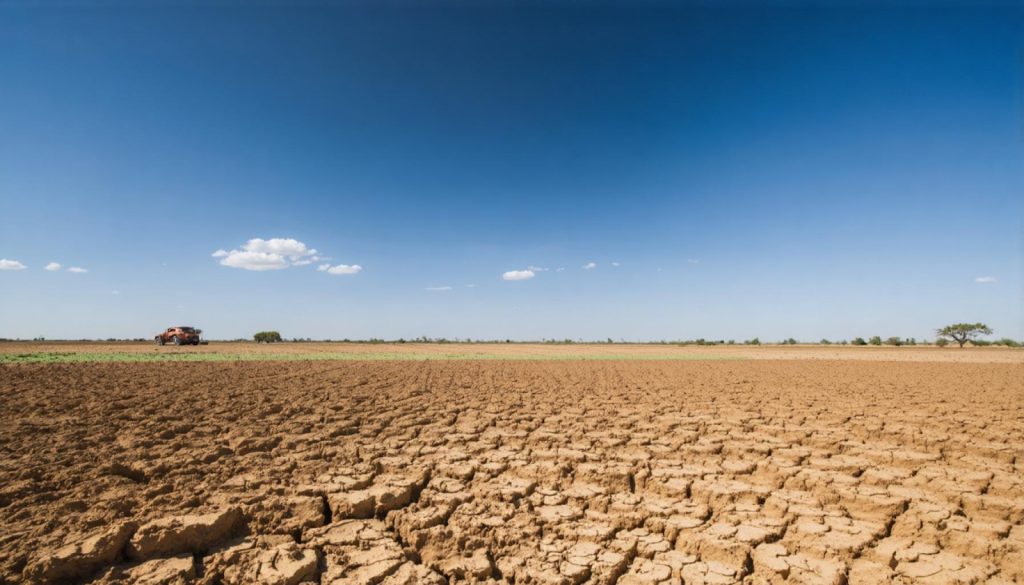
- Cloud computing, big data, and artificial intelligence are key to addressing drought prediction and management as climate change threats rise.
- Joseph Ayoade emphasizes AI’s role, achieving over 90% accuracy in weather forecasting to anticipate droughts proactively.
- AI-integrated irrigation systems optimize water use, interpreting satellite data to enhance resource conservation and crop yields.
- Global examples, like Israel’s desalination and Burkina Faso’s grassroots innovations, demonstrate diverse responses to water scarcity challenges beyond technology.
- Cloud computing underpins AI initiatives, yet the sustainability of these technologies depends on continued infrastructure evolution.
- The potential of quantum computing could further elevate AI capabilities, heralding new breakthroughs in drought management.
- Ayoade reassures that AI enhances human capability, creating new opportunities rather than replacing humanity.
- The ultimate challenge lies in creatively integrating technology with wisdom to address ancient environmental threats like drought.
In a world where climate change imposes increasing threats, the intersection of cloud computing, big data, and artificial intelligence offers a beacon of hope for addressing one of Earth’s most demanding challenges: drought prediction and management. Amidst this landscape, Joseph Ayoade, a respected IT innovator with expertise in AI-driven climate solutions, provides a compelling vision of how technology could reshape global water security.
From the vibrant energy of broadcast engineering to the precision of AI, Ayoade’s career trajectory reflects the shifting paradigms in technology. His quest for solutions began humbly, with simple automation problems, but swiftly evolved as he recognized artificial intelligence’s vast potential. Today, AI’s predictive prowess in weather forecasting—with over 90% accuracy—promises to revolutionize drought anticipation, offering a proactive approach starkly different from the reactive strategies of yesteryears.
Yet, the real magic unfolds when AI transcends mere prediction. In regions plagued by drought, AI-integrated irrigation systems stand as testament to technological advancement. Imagine an oasis, not borne of chance but of calculated precision—a symbiotic dance of satellite data interpreting soil’s whisper, directing even a single drop of water to its rightful place. By conserving precious resources and enhancing crop yields, these intelligent systems defy the odds against environmental depletion.
But this isn’t a tale of technology alone. Ayoade draws lessons from across the globe, illustrating how local ingenuity complements high-tech solutions. Israel’s triumph over drought through desalination and strategic irrigation showcases the power of willpower fused with resources. Conversely, the grassroots innovation of Burkina Faso, turning barrenness to greenery, steps away from technology towards human resilience, proving that solutions often reside in nuance.
At the heart of AI’s deployment lies an unseen force: cloud computing. Without such a backbone, AI’s transformative power stalls. Here, the flexibility and scalability of platforms like AWS ensure that burgeoning AI initiatives continue their ascent unhindered by infrastructure constraints. However, the breadth of AI’s potential places a looming question—can our current technological framework sustain this momentum?
The anticipation of quantum computing answers this call—a yet untouched horizon inviting further breakthroughs. Ayoade forecasts this quantum leap as the requisite next step, urging us toward advancements that promise not just continuity but evolution beyond the silicon frontier.
Amidst potential and promises, fear lingers—a societal unease that AI might eclipse human relevance. Yet Ayoade reassures us: AI is not our replacement but our empowerment. It crafts new opportunities and industries, urging us to wield it not with apprehension but with mastery.
As AI continues to unveil its endless possibilities, humanity stands on the cusp of a landmark transformation. The challenge is not the technology itself but our readiness to harness and integrate it creatively with enduring wisdom. Drought may be one of nature’s oldest foes, but armed with innovation, it might be the arena where we truly begin to reclaim our balance with the Earth.
Harnessing Technology: A Deep Dive into AI and Cloud Computing Solutions for Drought Management
In the dynamic world of technology, cloud computing, big data, and artificial intelligence (AI) converge to tackle one of Earth’s pressing challenges—drought prediction and management. As climate change exacerbates water scarcity, the innovative use of these technologies offers promising avenues for sustainable water security. Here, we delve deeper into how these technologies operate together, examine their real-world applications, and explore future trends and forecasts.
Advanced Insights into AI-Driven Drought Management
1. AI and Machine Learning Algorithms: AI, particularly through machine learning, can process vast datasets, uncovering patterns in meteorological data that are imperceptible to humans. This level of analysis, particularly using neural networks, enables predictions about drought occurrences with remarkable accuracy.
2. Cloud Computing as the Backbone: Platforms like Amazon Web Services (AWS) provide the essential infrastructure, allowing large-scale data processing and storage without the need for heavy investment in physical data centers. This flexibility is crucial for running complex AI models affordably and efficiently.
3. IoT and Real-Time Data Integration: Internet of Things (IoT) devices, such as sensors for moisture and weather conditions, feed real-time data into the AI systems. This continual flow of information enhances predictive models and supports precise water distribution, optimizing crop irrigation and conserving resources.
Real-World Use Cases and Strategies
– Israel’s Pioneering Techniques: Israel has successfully combated water scarcity using AI in conjunction with smart irrigation systems and desalination plants, resulting in a robust water management framework.
– Local Ingenuity in Action: In regions like Burkina Faso, simple yet effective soil and water conservation techniques complement high-tech solutions, enhancing their overall impact and ensuring sustainability.
Pros and Cons Overview
Pros:
– Increased agricultural productivity through optimized water use.
– Reduced environmental impact by lowering water waste.
– Enhanced predictability and proactive management of droughts, leading to resource savings and economic stability.
Cons:
– Initial setup costs for AI systems and cloud services can be significant.
– Dependence on digital infrastructure could pose risks if disrupted (e.g., cyber-attacks, outages).
– Technological reluctance in rural communities where traditional practices prevail.
Future Trends and Industry Forecasts
– Quantum Computing on the Horizon: Quantum computing promises unprecedented processing powers, likely drastically improving AI efficiency and model accuracy in predicting and managing droughts.
– Increasing Focus on Environmental Sustainability: Technology companies are expected to invest more heavily in sustainable computing solutions, further enhancing AI’s power in climate change mitigation.
– Crowdsourced Data for Enhanced Accuracy: Future systems might integrate crowdsourced data, further refining datasets and contributing to more accurate predictive models.
How-To Steps: Implementing AI-Powered Water Management Systems
1. Assess Needs and Goals: Understand the specific water management challenges and determine what the AI system should address.
2. Select Suitable Technology: Choose the appropriate AI and cloud computing platforms that match the scale and requirements of the system.
3. Data Collection and Integration: Deploy IoT sensors and other data collection tools to gather real-time, relevant data for AI processing.
4. Model Development and Training: Develop and train machine learning models to predict drought patterns and optimize water resource management.
5. Monitor and Optimize Systems: Continuously monitor system performance and optimize models based on feedback and new data inputs.
Quick Tips for Immediate Implementation
– Start small with pilot projects to demonstrate the value and efficacy of AI-powered systems in drought management.
– Foster partnerships with tech companies and academic institutions to leverage expertise and resources.
– Encourage community involvement and training to ensure technology adoption and sustainable use.
For further insights into cloud computing and artificial intelligence, visit Amazon Web Services and learn how their solutions can empower your water management strategies.
By leveraging AI and cloud computing, we can build resilient frameworks to not only combat droughts but also achieve broader environmental sustainability goals.



